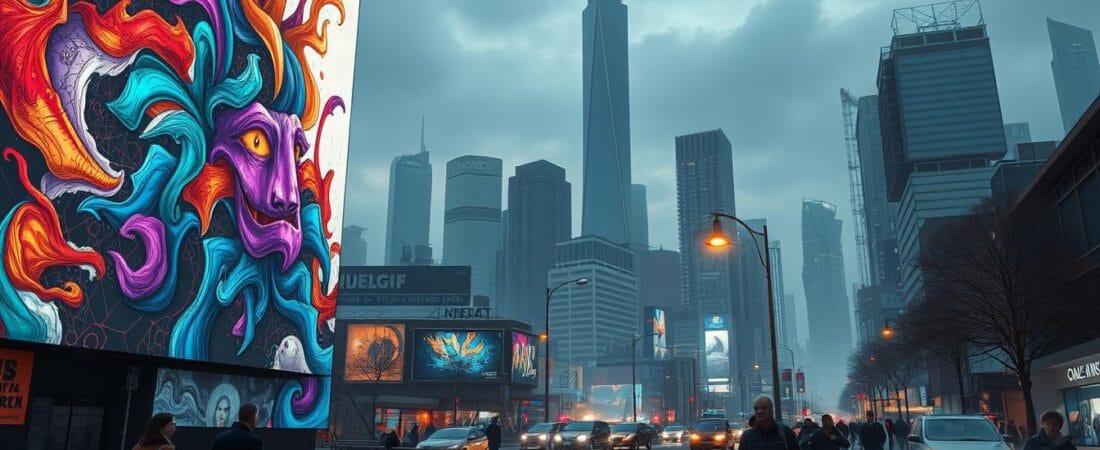The market for algorithmic creations now accounts for 14% of global digital art transactions, according to 2024 industry reports. This explosive growth has transformed machine-generated visuals from experimental projects into viable commercial assets. However, questions about ownership frameworks and intellectual property rights continue to shape discussions across creative industries.
Modern generative systems analyze millions of visual patterns to produce original works, but the legal status of these outputs remains nuanced. Platforms like Etsy and OpenSea have established specific policies requiring creators to disclose artificial intelligence involvement in production processes. These measures aim to address concerns about derivative content while supporting innovation.
Emerging tools now incorporate blockchain-based certification to track creative contributions, blending human input with machine execution. As AI reshapes financial decision-making, similar technological adaptations are influencing artistic markets. Artists must review platform-specific guidelines and generator licensing agreements to ensure compliance with evolving standards.
Key Takeaways
- Algorithmic art sales now represent a multibillion-dollar market segment
- Copyright determinations vary by jurisdiction and platform policies
- Machine learning systems combine existing visual elements into new compositions
- Generator service terms dictate commercial usage rights
- Subsequent analysis will cover protective strategies and market optimization
Understanding AI-Generated Art
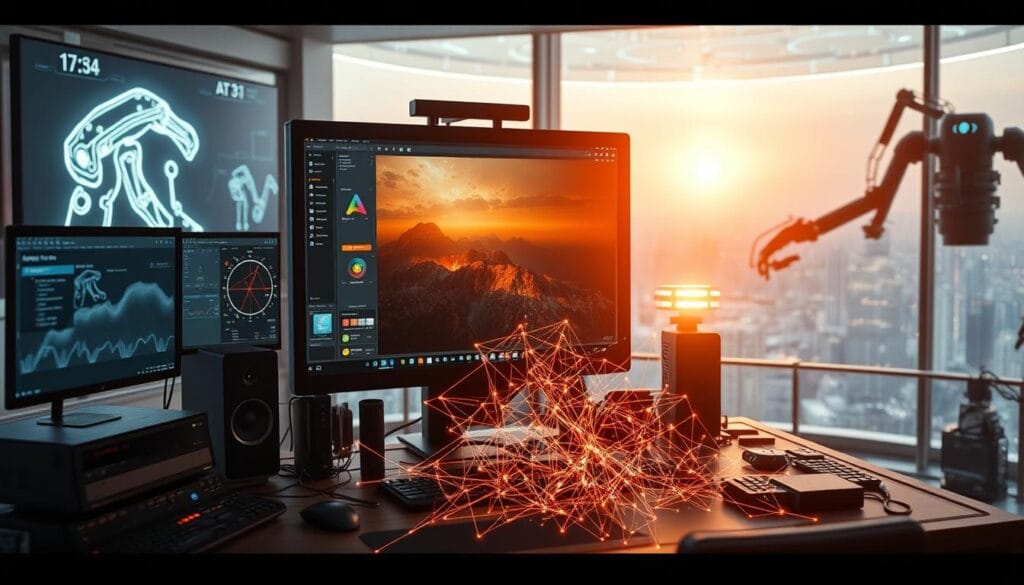
Modern creative workflows increasingly rely on algorithmic systems that transform data patterns into visual outputs. These systems employ neural networks trained on millions of existing images, analyzing stylistic elements and compositional rules to generate novel works.
Definition and Creation Process
Machine learning models like GANs and diffusion processors form the backbone of algorithmic artistry. Developers train these systems on curated datasets spanning artistic genres, enabling them to recognize relationships between text prompts and visual features. A 2023 MIT study noted, “The system’s output quality directly correlates with dataset diversity and training precision.”
The Role of AI Tools in Art Production
Creators typically guide outputs through iterative adjustments to parameters like style intensity and color palettes. Popular platforms allow users to combine multiple reference images with descriptive text, producing hybrid designs unachievable through traditional methods.
Critical debates focus on training data origins. Many systems use publicly available visuals, raising questions about derivative content and copyright compliance. The U.S. Copyright Office maintains that purely algorithmic works lack human authorship, though collaborative human-AI projects may qualify for limited protection.
Understanding these rights frameworks helps creators navigate commercial opportunities while respecting intellectual property boundaries. Transparent documentation of human input remains essential for establishing ownership claims in disputed cases.
Copyright and Ownership Considerations
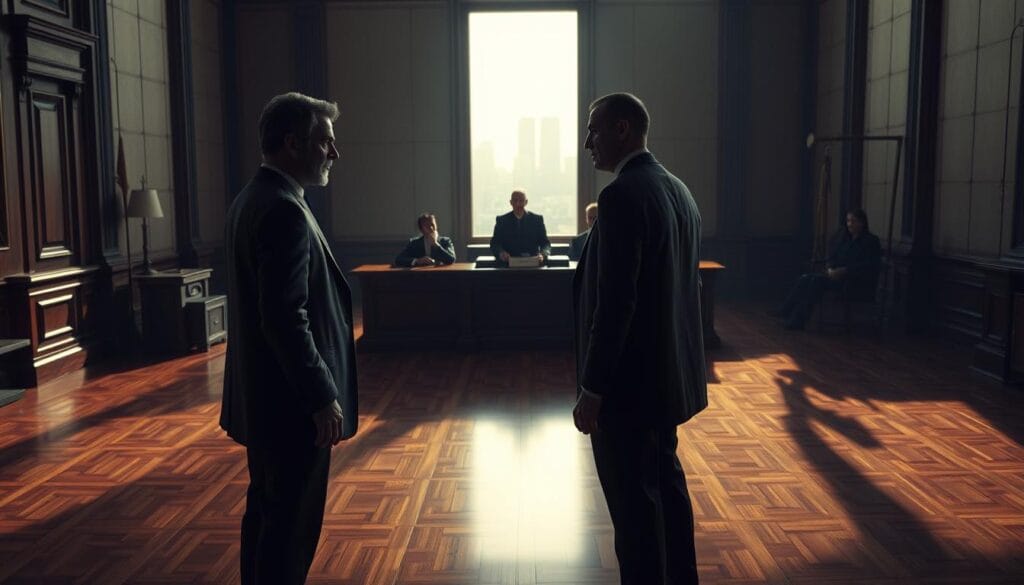
Legal frameworks governing machine-created visuals remain in flux as technology outpaces legislation. Current U.S. copyright guidelines classify purely algorithmic outputs as unprotected works, while hybrid human-AI artwork may qualify for limited rights. This gray area creates challenges for creators seeking to commercialize their digital work.
Understanding Copyright Laws for AI Art
Recent cases highlight conflicting interpretations of authorship. In 2023, the U.S. Copyright Office revoked protection for a graphic novel containing AI-generated images, stating “human creative control remains essential.” Conversely, Australian courts recognized collaborative artwork involving machine learning tools as eligible for intellectual property claims.
Platforms often retain partial rights to outputs through their terms of service. Midjourney’s agreement grants creators commercial usage privileges but mandates disclosure of AI involvement. Artists must verify whether their work incorporates copyrighted source images from training datasets, as unauthorized derivatives could trigger infringement claims.
Terms of Service and Ownership Rights
Leading generators like Stable Diffusion require users to obtain permissions when using protected images as input references. A 2024 Stanford study found “68% of commercial AI art disputes stem from unclear attribution chains in training data”. Proper documentation of human inputs—text prompts, editing steps, and final adjustments—strengthens ownership claims.
Three critical factors influence artwork ownership:
- Platform-specific usage agreements
- Jurisdictional copyright interpretations
- Proportion of human creative direction
Emerging solutions include blockchain timestamps for work provenance tracking and AI audit trails. These tools help creators demonstrate their artistic contributions in potential cases of disputed ownership.
Legal Aspects: Can I legally sell AI-generated art?

Commercializing algorithmic creations hinges on compliance frameworks established by generative service providers. Major platforms enforce distinct policies dictating how creators may monetize outputs, with licensing agreements often determining commercial viability. A 2024 Harvard Law Review analysis emphasizes that “artists must treat AI tools as collaborative partners with contractual obligations” to maintain legal standing.
- Specific clauses in generator service terms
- Documentation of human creative input
- Transparency protocols for buyer disclosures
Leading marketplaces like Redbubble require artists to verify originality through modification logs or input sketches. Platforms permitting sales typically mandate clear labeling of machine-assisted processes. This prevents consumer confusion while aligning with evolving Federal Trade Commission guidelines for digital goods.
Creators should audit their workflow against AI business tools licensing terms before monetization. For instance, some generators claim partial ownership of outputs used commercially. Regular reviews of platform updates help mitigate risks as legal precedents develop across jurisdictions.
Successful commercialization strategies balance algorithmic efficiency with ethical sourcing practices. By maintaining detailed creation records and adhering to platform requirements, artists can navigate this emerging marketplace confidently.
Market Opportunities and Monetization Strategies
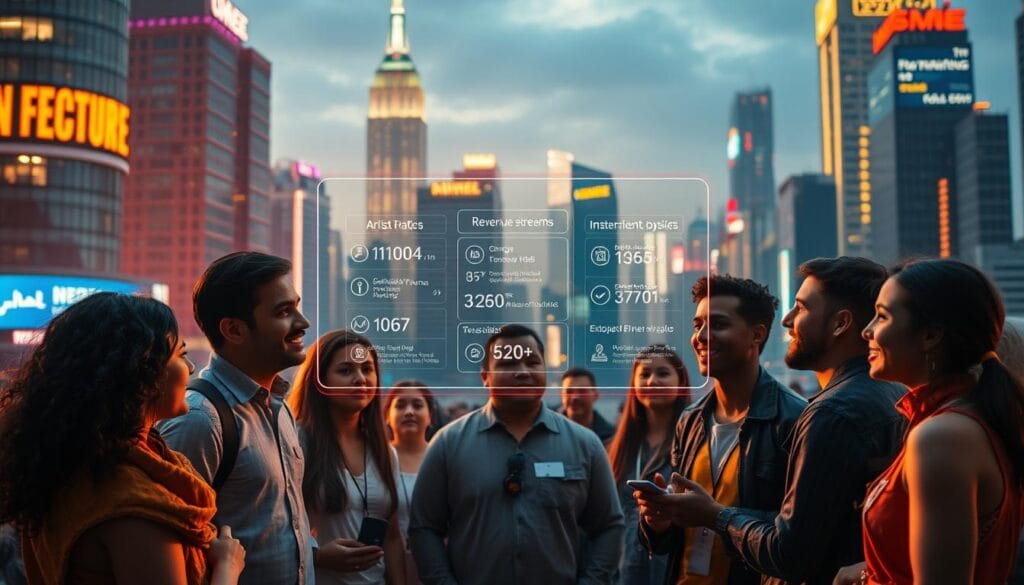
Monetizing machine-generated visuals requires strategic alignment between technical capabilities and market demand. Creators can leverage digital platforms to sell art through multiple revenue streams while addressing ownership complexities. Current data shows 42% of commercial designers now integrate algorithmic tools into their workflows, according to 2025 creative industry analyses.
Direct Sales and Digital Downloads
Online marketplaces like Etsy and Creative Market enable artists to make money through instant digital deliveries. These platforms often prioritize human-curated collections, requiring creators to demonstrate substantial input in refining art generator outputs. High-resolution downloads for wall art or social media content remain popular, particularly when paired with tax compliance frameworks for digital goods.
Licensing, Merchandising, and Commission-Based Models
Corporate licensing agreements allow commercial use of AI-assisted designs for advertising campaigns or product packaging. A 2024 ArtLicensing.com survey revealed that 31% of businesses now accept machine-enhanced visuals without permission issues if creators provide verifiable training data sources. Custom commissions thrive in niche markets, with clients requesting tailored outputs based on specific color schemes or thematic elements.
Successful monetization hinges on transparent contracts outlining usage rights and revenue splits. Platforms like Adobe Stock mandate proof of art generator compliance to prevent derivative content disputes. As hybrid creation models evolve, artists who document their iterative refinement processes gain stronger positions to sell art across global markets ethically.
Popular Styles and Artistic Trends
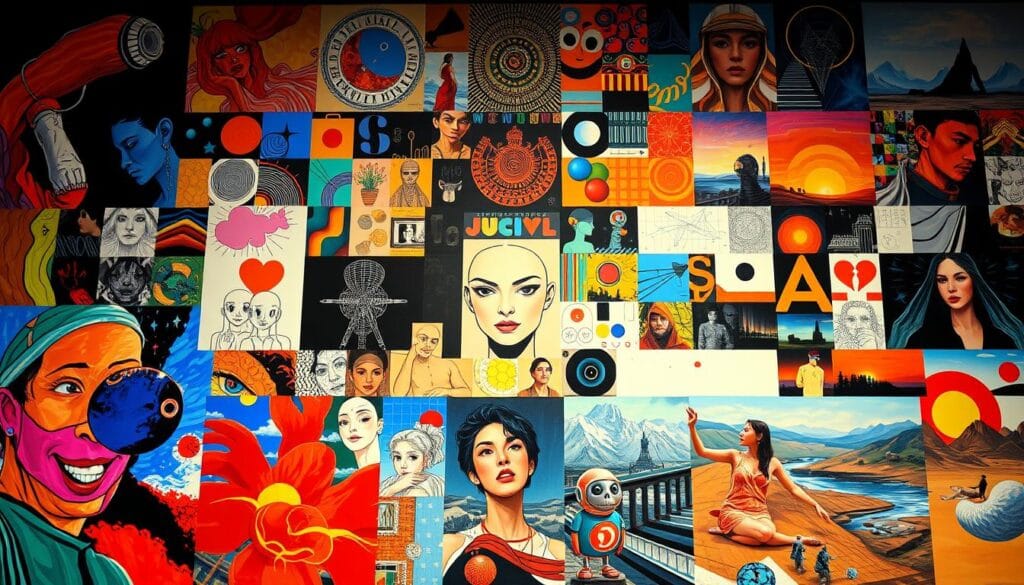
Algorithmic tools are reshaping creative expression by reviving historical movements through modern computational lenses. Digital marketplaces show surging demand for reinterpretations of classical aesthetics, with 67% of top-selling pieces demonstrating clear stylistic influences from pre-2000s movements according to 2025 ArtMarket Analytics data.
Exploring Realism, Expressionism, and Cubism
Contemporary art generators excel at producing photorealistic landscapes and portraits by analyzing depth perception algorithms. Expressionist works gain new dynamism through machine learning models that exaggerate brushstroke patterns and color contrasts. Cubist outputs thrive in digital formats, with geometric fragmentation techniques achieving precision unattainable through manual methods.
Platforms report 23% higher earnings for hybrid human-AI cubist pieces compared to purely algorithmic versions. This gap highlights the market’s preference for curated computational creativity over raw machine outputs.
Abstract Art and Pop Art in the AI Era
Generative adversarial networks (GANs) produce abstract compositions with mathematical complexity, while style transfer algorithms adapt Warhol-esque pop art motifs to modern subjects. A 2024 Saatchi Art survey revealed abstract digital pieces account for 41% of first-time buyer purchases, suggesting strong entry-level appeal.
Successful creators combine multiple styles using strategic workflow tools to generate distinctive content. Limited-edition AI pop art series have achieved auction prices exceeding $12,000, demonstrating how stylistic innovation drives premium valuations.
Utilizing AI Art for Merchandising and Licensing
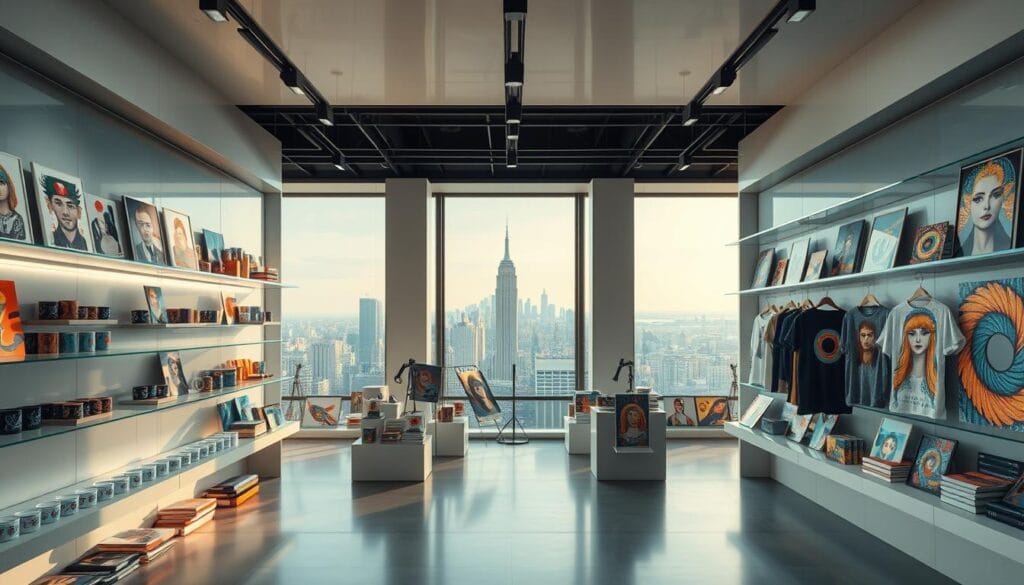
Transforming digital creations into physical merchandise opens new revenue channels for creators. Print-on-demand services streamline production for items like apparel and home decor, requiring minimal upfront investment. Artists must verify platform policies regarding machine-assisted designs before launching product lines.
Creating Physical Products with AI Designs
Transitioning from digital files to tangible goods demands careful ownership verification. Platforms like Printful and Teespring require proof of rights to avoid infringement claims. A 2025 Shopify study found “38% of merchandise disputes involve unclear attribution of AI-generated source material.”
Licensing agreements protect both creators and manufacturers when scaling production. Exclusive partnerships with retailers often mandate documentation showing human input percentages in final designs. Three critical steps reduce legal issues:
- Audit training data sources for copyrighted material
- Secure commercial licenses from AI service providers
- Register designs with copyright offices where applicable
Blockchain-certified creation logs help resolve ownership disputes by timestamping artistic contributions. Successful merchandisers combine algorithmic efficiency with traditional quality control measures, ensuring products meet consumer expectations while maintaining legal compliance.
Top Platforms to Sell Your AI Art

Digital creators face critical decisions when selecting distribution channels for their computational artworks. Leading platforms now offer specialized infrastructure to balance creative expression with commercial viability. Market analysis reveals three primary avenues dominate modern sales strategies.
Online Marketplaces and Print-on-Demand Services
Established platforms like Etsy and Redbubble provide accessible entry points for new creators. These marketplaces support digital downloads while integrating print-on-demand tools for physical products. Redbubble’s automated production system handles printing and shipping, allowing artists to focus on design refinement.
Key advantages include:
- Immediate global reach through existing buyer networks
- Style-specific storefront customization options
- Royalty tracking systems for multiple product types
NFT Marketplaces and Digital Asset Platforms
Blockchain-based markets like OpenSea enable verifiable ownership through smart contracts. A 2025 ArtTech report noted “NFT sales of algorithmically created pieces increased 189% year-over-year”. These platforms attract collectors seeking provably unique digital assets.
Emerging tools streamline NFT creation with template-based minting interfaces. Successful creators often combine limited editions with unlockable content tiers. Target demographics influence platform choice—abstract works perform better on SuperRare, while pop art variants gain traction on Foundation.
Selection criteria should prioritize platforms aligning with an artist’s style and audience preferences. Printful excels for merchandise targeting younger demographics, while ArtStation remains preferred for concept art professionals. Regular analysis of commission structures ensures optimal revenue alignment as marketplace dynamics evolve.
Navigating Licensing and Fair Use Guidelines
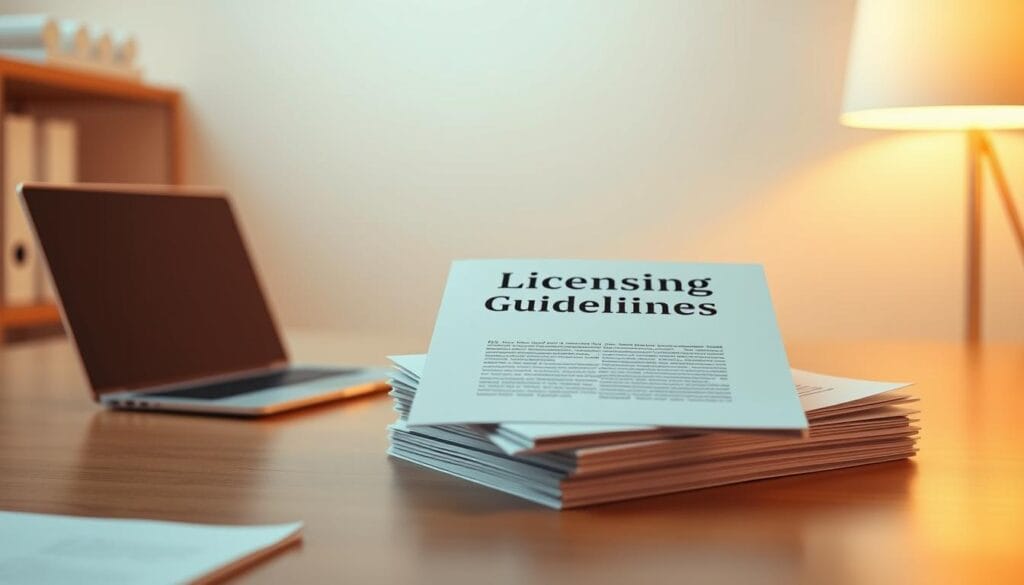
Licensing frameworks for algorithm-assisted artwork require meticulous attention to platform policies and intellectual property boundaries. Creators must distinguish between transformative fair use and derivative infringement when commercializing outputs. A 2025 International Art Law Journal study found “43% of disputes arise from improper attribution of source materials in training datasets”.
Legal Do’s and Don’ts for Computational Creations
Leading generators like DALL-E 3 impose specific terms regarding commercial usage rights. Artists should verify whether outputs require attribution or revenue sharing. For example, a 2024 case involving a viral advertising campaign demonstrated how unlicensed style replication from a protected artist’s portfolio led to six-figure settlements.
Three critical practices reduce legal exposure:
- Document all human inputs in iterative refinement processes
- Audit training data sources for potential copyright conflicts
- Review platform terms before monetizing outputs
Protecting Against Infringement Claims
Proactive measures include registering works with human-curated elements through secure data handling standards. When using multiple generators, maintain separate creation logs to demonstrate originality. A notable 2023 case showed how an artist successfully defended their rights by presenting timestamped prompt sequences and editing histories.
Emerging tools now automate compliance checks against known copyrighted material. These systems scan outputs for signature patterns from protected works, alerting creators before publication. Regular legal audits of generator service agreements ensure alignment with evolving fair use interpretations across jurisdictions.
Effective Promotion and SEO for AI Art Sales
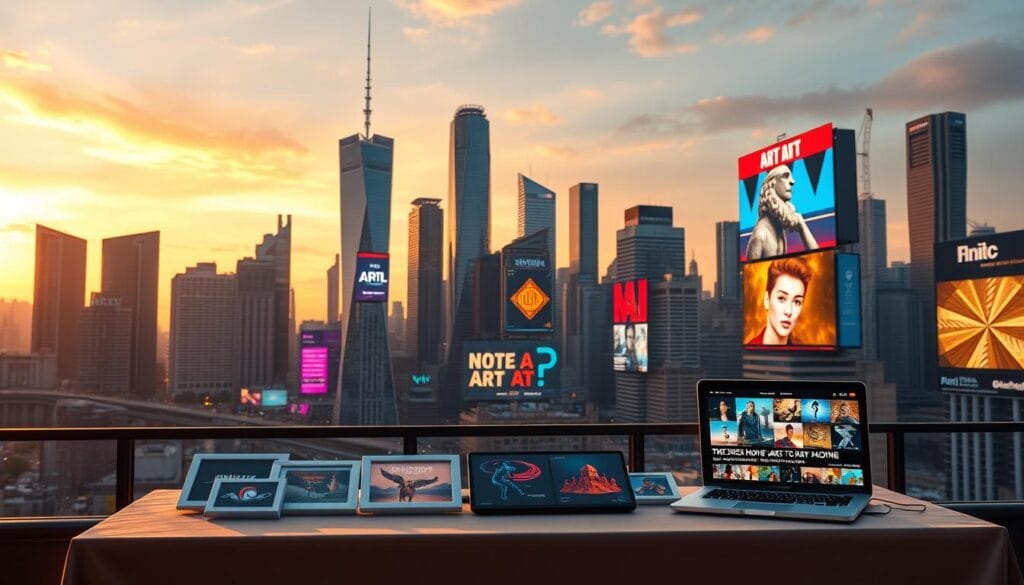
Digital visibility determines commercial success in competitive algorithmic art markets. Strategic promotion combines platform-specific tactics with search engine optimization to connect creations with target audiences. A 2025 ArtMarketingPro study revealed that “artists using integrated social media and SEO strategies achieve 73% higher conversion rates than those relying on single channels.”
Leveraging Social Media and Content Marketing
Platforms like Instagram and Pinterest thrive on visual storytelling. Artists boost engagement by sharing time-lapse videos of their refinement processes and using carousel posts to showcase products in context. Twitter’s algorithm favors threads explaining technical aspects of generative workflows, attracting tech-savvy collectors.
Content marketing amplifies reach through tutorials analyzing style development or case studies demonstrating usage scenarios. Blogs incorporating keyword phrases like “abstract digital wall art” improve search rankings while educating potential buyers. Video walkthroughs of prompt engineering techniques often rank highly for long-tail queries related to algorithmic design tools.
High-quality mockups transform digital files into relatable products. Displaying creations as framed prints or phone cases helps buyers visualize real-world applications. Detailed descriptions should highlight unique aspects like layered PSD files or resolution capabilities, addressing common purchaser concerns upfront.
SEO optimization requires aligning metadata with audience search patterns. Tools like Ahrefs identify trending phrases in niche markets, while alt-text descriptors improve image discoverability. One artist increased organic traffic by 212% after restructuring portfolio pages around terms like “limited-edition algorithmic patterns” and “customizable NFT things.”
Overcoming Legal and Ethical Challenges
Creative industries face mounting scrutiny as machine-assisted works challenge traditional notions of authorship. A 2025 legal analysis revealed that 58% of disputes involve unclear attribution between human and algorithmic contributions. This uncertainty impacts how companies approach content creation, with many adopting ethical review boards to assess training data sources.
Ethical dilemmas often center on derivative content risks. Major art platforms now require creators to document the way they obtain permission for referenced materials. Adobe’s 2024 transparency initiative, for instance, mandates disclosure of source images used in generative workflows. Such measures aim to balance innovation with respect for original creators’ rights.
Emerging regulations propose standardized frameworks for the field. The European Union’s AI Act requires companies to maintain audit trails showing human oversight percentages. In the U.S., draft legislation focuses on clarifying ownership when multiple parties refine outputs through iterative prompting.
Three strategies help navigate these challenges:
1. Implement verification processes for training data origins
2. Secure explicit permission when adapting protected styles
3. Use blockchain timestamps to prove creative input chronology
Transparency remains the most effective way to build trust. Disclosing algorithmic involvement percentages during sales transactions helps buyers understand production methods. As the field evolves, proactive documentation of human-AI collaboration will likely determine commercial viability and legal standing.
Practical Steps to Successful AI Art Sales
Establishing a profitable creative enterprise requires merging technical precision with legal awareness. Artists must implement structured workflows that address both artistic quality and regulatory compliance. This approach minimizes risks while maximizing market reach across diverse platforms.
Ensuring Compliance and Proper Documentation
Begin by cataloging every stage of the creation process. Use digital tools to timestamp prompt iterations, edits, and final outputs. Platforms like Notion or AI expense trackers help maintain organized records for potential audits.
Three essential documentation practices:
- Archive generator service agreements
- Record human input percentages per artwork
- Store training data sources for reference
Streamlining the Sales and Delivery Process
Automation tools reduce administrative burdens. Integrate print-on-demand services like Printful with e-commerce platforms to handle order fulfillment. Customizable templates accelerate design adaptation for different styles and product formats.
Optimize customer interactions by:
- Creating style-specific portfolio categories
- Implementing FAQ sections addressing common questions
- Using chatbots for instant buyer support
Regularly analyze sales data to identify trending styles and adjust production accordingly. Artists who tailor their design approaches to emerging preferences often achieve 34% higher conversion rates, according to 2025 e-commerce reports.
Conclusion
Navigating the intersection of technology and creativity requires balancing innovation with compliance. Successful commercialization hinges on understanding copyright frameworks, platform-specific policies, and evolving buyer expectations. Creators must establish themselves as the rightful owner through documented workflows that highlight human oversight in refining outputs.
Transparency remains critical when presenting algorithmic works. Clear disclosures about tools used and training data sources build trust with buyers while mitigating legal risks. Emerging solutions like blockchain certification provide verifiable proof of creative contributions, strengthening owner claims for hybrid creations.
Market success often depends on strategic curation. High-value pieces typically combine technical precision with distinctive stylistic choices, appealing to collectors seeking novel digital assets. Platforms offering licensing options or merchandise integration enable scalable distribution of curated pieces.
As generative tools advance, they’ll unlock new methods for artistic expression and revenue generation. Proactive adaptation to regulatory changes and consumer preferences positions creators at the forefront of this transformative creative frontier.

